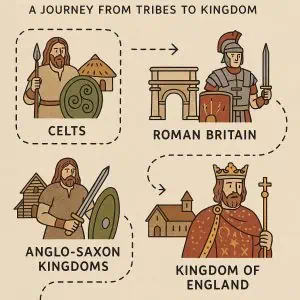Medieval towns in England are enduring testaments to a vibrant and transformative era in history. With their narrow, winding streets, bustling marketplaces, and distinctive architecture, these towns offer a captivating window into the daily life and culture of the Middle Ages. From timber-framed houses to grand cathedrals and fortified walls, each element reflects the complexities and character of medieval urban life in England.

The Rise and Life of Medieval Towns in England
From Rural Settlements to Thriving Towns
The development of medieval towns in England marked a pivotal shift from scattered rural communities to more centralized, fortified urban centers. This transformation accelerated after the Norman Conquest of 1066, when the Normans built motte-and-bailey castles across the land. These strongholds often became focal points for emerging towns, offering protection and economic opportunity. Historic towns like Lincoln, York, and Winchester began to take shape during this period.
Several factors contributed to the growth of these towns. The expansion of trade and commerce, improvements in agriculture (especially the three-field system), and the granting of charters by monarchs all played crucial roles. These charters often included special rights and privileges that encouraged settlers to stay and do business—laying the foundation for urban growth.
Urban Design and Medieval Architecture
Medieval towns were typically laid out in a seemingly chaotic pattern, with narrow, winding streets forming as towns grew organically over time. At their heart were lively marketplaces and central squares, often flanked by important buildings like guildhalls or town halls.
Architecturally, towns were a mix of modest homes and grand religious structures. Half-timbered houses, with exposed wooden frames, became a common feature. Meanwhile, towering stone churches like Canterbury Cathedral and Salisbury Cathedral stood as spiritual and architectural landmarks. Many towns were also enclosed by defensive walls, built to ward off threats, and punctuated by grand gateways that controlled access.
Governance and Daily Life
The governance of medieval towns was deeply tied to the charters granted by monarchs. These documents allowed towns a degree of self-rule, enabling them to hold markets, collect tolls, and establish guilds—powerful trade organizations that regulated economic activity and provided support to members.
Social life in medieval towns followed a clear hierarchy. At the top were wealthy merchants and guild masters, followed by skilled tradespeople, laborers, and servants. Guilds not only controlled the standards of goods and services but also shaped the social and economic life of the town.
Commerce, Craft, and Industry
Market towns emerged as commercial hubs, attracting traders, artisans, and farmers from the countryside and beyond. Regular fairs, often lasting several days, provided a venue for widespread trade and cultural exchange.
Craftsmanship flourished within town walls. Skilled artisans—such as blacksmiths, weavers, cobblers, and brewers—formed the backbone of the local economy. Larger industries, including textile production, mining, and metalworking, also began to thrive in many urban centers.
Community, Culture, and Belief
Religion permeated every aspect of life in medieval towns. Parish churches, monasteries, and chapels were not just places of worship—they were also cultural and community hubs. Their presence highlighted the central role of Christianity in shaping medieval society.
Towns were vibrant with festivals, pageants, and religious processions. Celebrations like May Day brought the entire community together, offering moments of joy in an otherwise labor-intensive life.
Education found a home in the towns as well. Schools, and later universities, emerged, turning some towns into centers of learning and scholarship. These institutions nurtured intellectual exchange and laid the groundwork for future advancements during the Renaissance.
Conclusion: A Legacy That Endures
Medieval towns in England offer a remarkable lens through which to explore the Middle Ages. Their architecture, markets, and community traditions continue to fascinate modern visitors. Each cobblestone street and timber-framed house tells a story—of trade and toil, of devotion and delight.
To walk through these towns is to step into history. Whether you’re exploring the grandeur of a medieval cathedral or tracing the outline of ancient town walls, the legacy of medieval urban life is alive and well. Uncovering the history of these towns is not just an academic pursuit—it’s a journey through a vibrant and enduring past.






